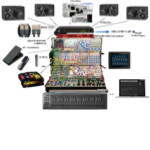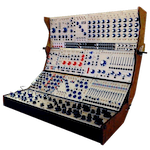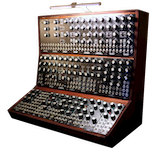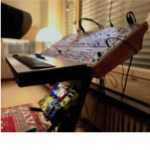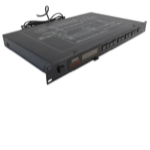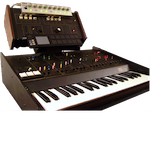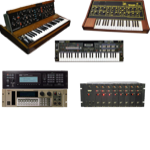Eurorack
3U Modular Synthesizer Format
This was my very last complete Eurorack instrument, which only existed for about half a year. A 600TE touring instrument that can be easily folded (in a patched state) and then is about as big as a tenor saxophone case. It was perfect for me in terms of transport handling, however I actually wasn't happy with the very small Eurorack format (12V) itself. When I got the opportunity in 2015 to take over some Buchla Clone modules from Roman F. (the man who had developed many of those Buchla Clones), I unceremoniously parted ways with no regrets and switched to the Buchla 200 Series, which had what I k was looking for. However, I still carry a few Eurorack modules today.
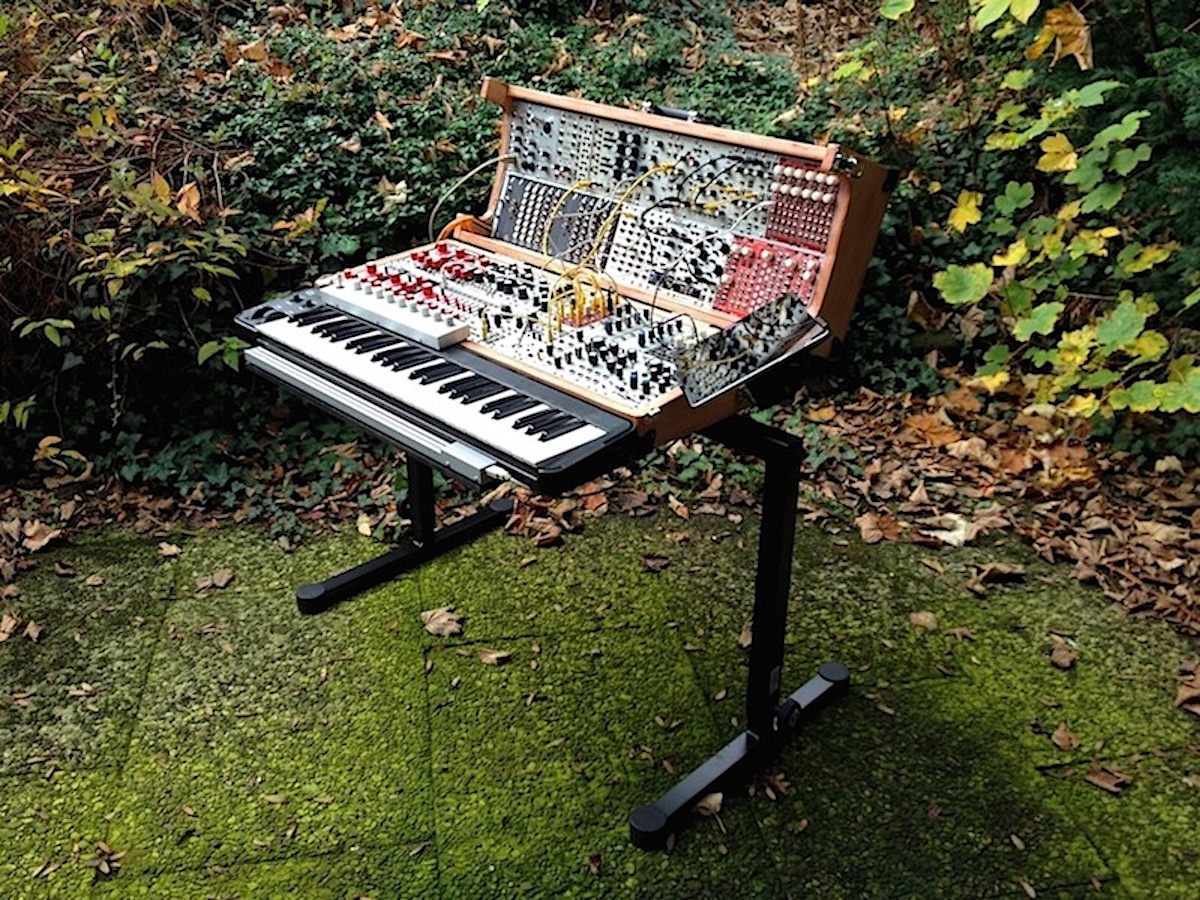
Eastcoast - Westcoast
In 2012, I had decided to realize a more travel-friendly EURORACK instrument because of the easier transportation (at that time I only had the 5U MOTM format). It was only two years after I had changed from ARP instruments to the MOTM Modular format (5U 15V) after 30 years and I was very pleased with the sound. However, MOTM was not ideal for traveling. It was quite bulky and also weighty. As I figured out later, the patch cables of my MOTM alone were heavier than my whole, first Eurorack instrument, both patched and in a wooden travel case!
While my MOTM synth was designed "eastcoast" (Filter focus and ADSR with VCAs), I had designed the Eurorack synth "westcoast", i.e. a bit on the FM side, with waveshaping and LoPass Gates. I loved that. However, I suffered from the appearance of the "Frankensynth" and I felt the Mini-Pots were rather unpleasant to tweak. The change from sliders (ARP) to knobs (MOTM) was much more pleasant than I had expected, but the Eurorack format was overall too "fiddly" and too cramped for me - and then there still was this screeching optics.
In addition, I rather was on the "15V track" - that had already started with ARP: While the ARP 2600 had 15V operating voltage, the Odyssey (I got the first one in 2006) only had 12V - and it somehow sounded smaller, less powerful. I had countered that with the ARP Little Brother (an expander with a 2600 oscillator). However, I also was missing some things on the Odyssey that I used to really appreciate on my ARP 2600. So I finally ended up in the Modular formats - and the "problems" had obviously come along. I'm just trying to describe my path, and that it consistently led to Buchla. Well, I hear more and more very well sounding music - from Eurorack instruments…
New Beginning - with CV signals for other formats
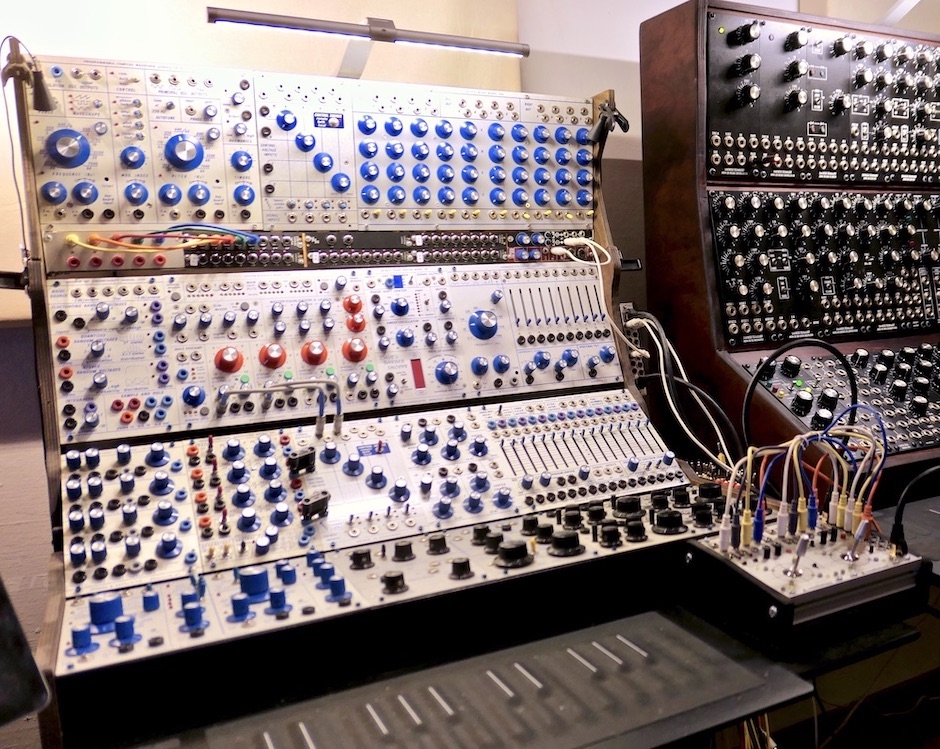 I never left the Eurorack completely anyway - the 80 Audio to CV outputs of the Expert-Sleepers modules alone require around 100 HP and they are substantial when it comes to my work on the Hybrid-Modular. For me, the Expert Sleepers modules are the key modules for controlling the synths.
I never left the Eurorack completely anyway - the 80 Audio to CV outputs of the Expert-Sleepers modules alone require around 100 HP and they are substantial when it comes to my work on the Hybrid-Modular. For me, the Expert Sleepers modules are the key modules for controlling the synths.
One half of my Expert-Sleepers modules, which provides 40x CV from a single SPDIF stereo audio signal - an ES-40 with 5 Expansion Modules - lives in and on my Buchla (1.2V/Oct) and delivers 32x CV and 8x Gate.
Audio to CV / CV to Audio - also for “non-programmers”
To me, the Expert-Sleepers modules are THE missing link par excellence! A modular system suddenly takes on a whole new meaning! Calibration and tuning can be automated! Sounds, if patched identically, are exactly reproducible even with the most complicated value changes - which is exactly what is otherwise simply unthinkable with such a system…

It is the perfect combination of computer and synthesizer. For “non-programmers” there is a fantastic collection of extremely useful CV plug-ins from Expert-Sleepers called “Silent Way PlugIn Suite”. DC, LFO, Step LFO, Quantizer, Trigger, CV Input, CV To OSC, CV To MIDI, AC Encoder and Voice Controller. This means that incoming CV values can also be converted into MIDI or OSC data. Thanks to the OSC compatibility, corresponding controllers, e.g. on iPhone or iPad, can be realized quite easily. All parameters also have a MIDI address. This is VERY extensive - the Voice Controller on its own has 122 parameters! Traveling modulists in particular will like the fact that the included functions allow them to leave some modules at home in the future.
This video is a good example of how easy it is - especially with the Silent Way plug-ins - to send, edit and receive CV:
CV can also be generated directly from audio interfaces (with “coupled DC” audio outputs), but has too many flaws (e.g. lack of volts). Because I needed the analog audio outputs of my audio interface for audio, I didn't even start with it. The digital transmission via SPDIF, AES or ADAT (Expert-Sleepers) also avoids a double DAAD conversion and the signal strengths, if transmitted digitally, do not have to be calibrated regularly, as it is required with CV from analog audio outputs. Finally, the convincing argument is that I get 40x CV with two digital audio channels, while only 1x CV per audio channel is possible with analog audio!
In the following image you can see all Eurorack modules that are on my Buchla. I am also particularly enthusiastic about the Intellijel Planar modules, which I primarily use as vector mixers for audio on the Buchla. The mono outputs of the two Intellijel Planar modules run into the Dual VCA and with the ADDAC FootControl I control one of the two VCAs via Expression Pedal.
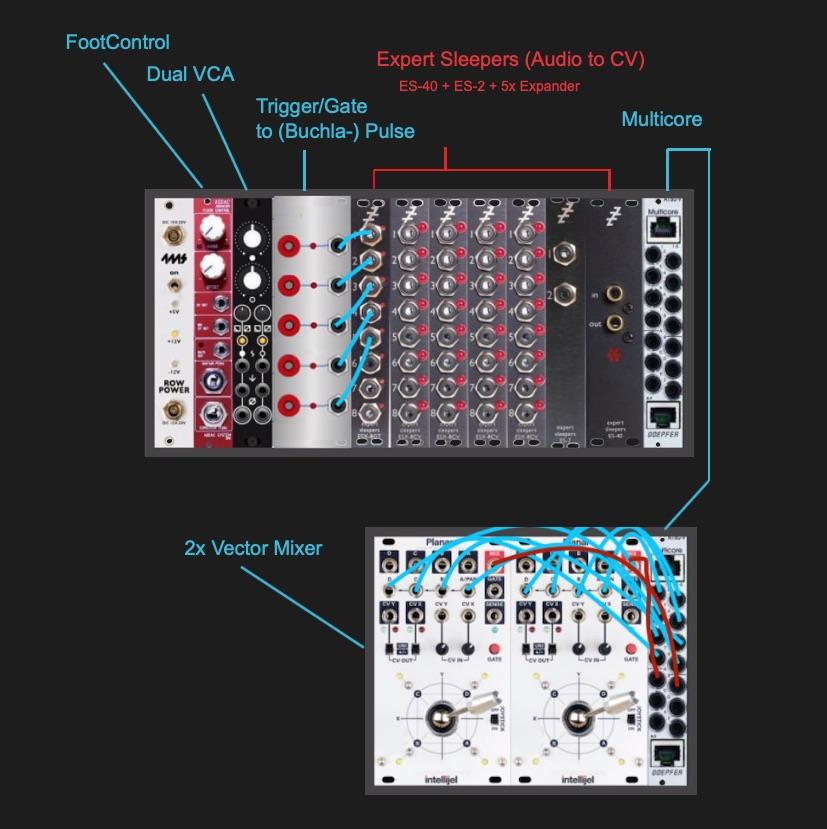
The Eurorack has such important and great modules - in fact, no matter what format you're at home in, the easiest solution to a problem is often obtained with Eurorack modules. The “Trigger/Gate to Buchla Pulse” module (above) from Synovatron is a perfect example of such a solution. Sadly, Synovatron has ceased to exist in 2021.
MIDI to CV
Another example: the ARP Little Brother requires 15V triggers - and the Kenton “Modular Solo” MIDI to CV interface can provide them (Pgm 27). In this case, it was also important to add an audio amplifier in order to compensate the differences in volume between ARP (line) and the Eurorack format (+12dB)...
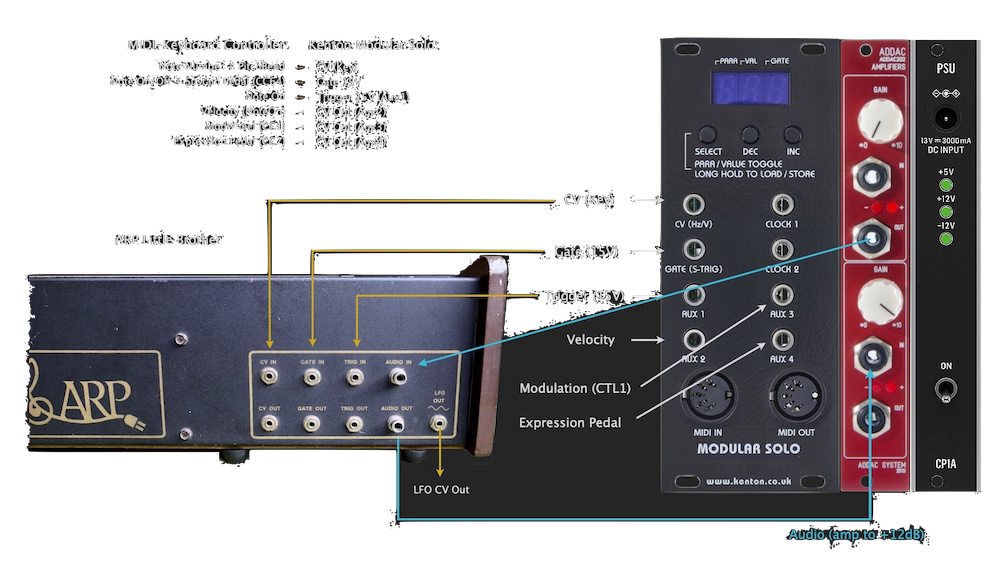
An Editor for the Kenton "Modular Solo" module
After finding the operation of the Kenton Modular Solo module very unpleasant, I built an Editor - and I don't understand why there are no editors for the Kenton interfaces yet. Making all settings via three push buttons on the module is extremely outdated and the manual with the list of parameters needs to be consulted, as the rapidly scrolling abbreviations for the parameter names on the three-digit LCD are almost impossible to read (and comprehend). The Editor takes operability to the 21st century.

Using the Editor with an iPad ( using the MIRA app) is unbeatable - a real pleasure! I have placed the clocks of the Kenton Modular Solo (and a few system settings) in a second TAB. No other controller can do it like this. For the realization of the Editor I used MAX.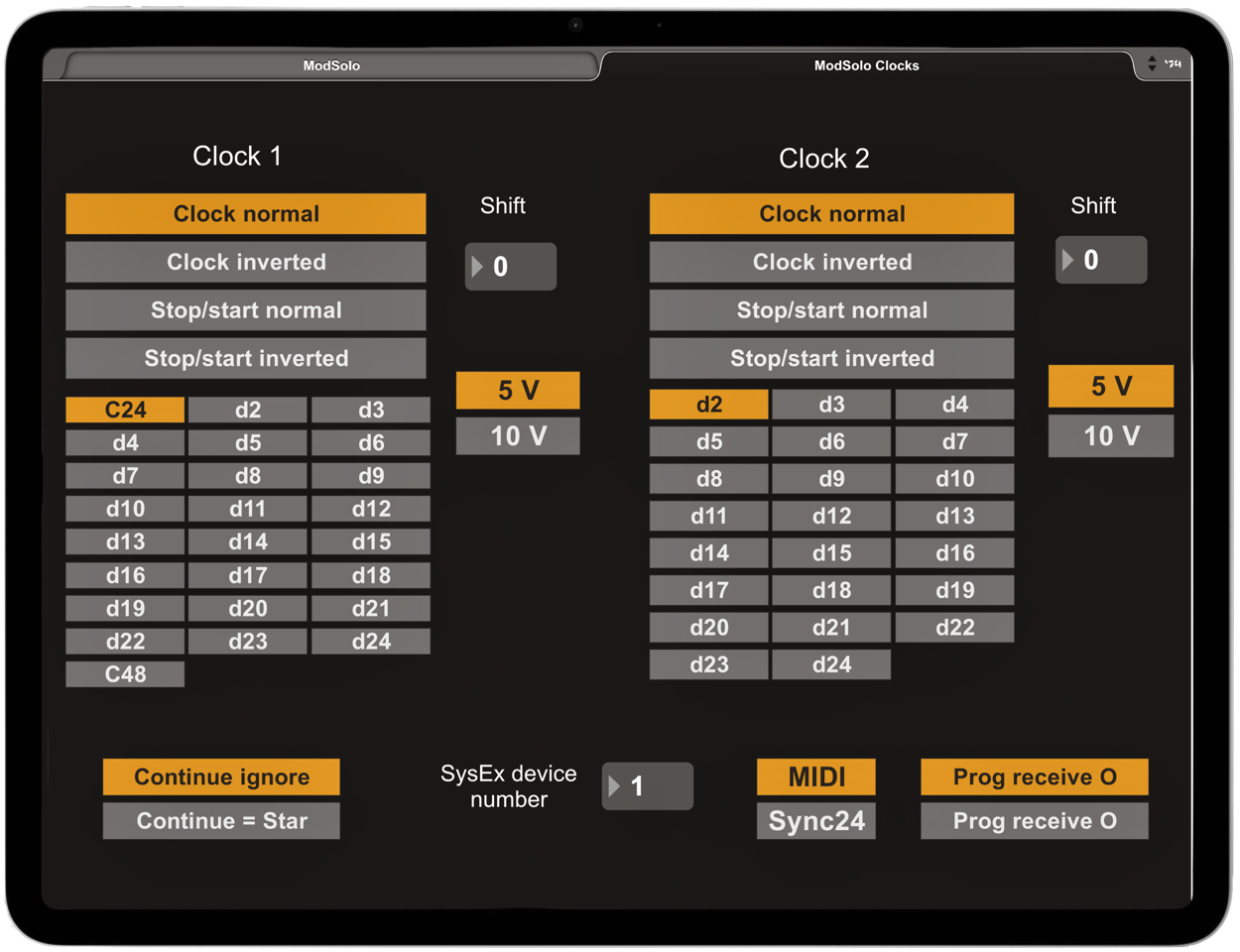
Compared to the Expert Sleepers ES 40 (Audio to CV) in particular, however, the Kenton module has some disadvantages for my purposes. Worth mentioning here is the "enormous" depth of 8 cm and the rather weak LFO, which is rich in waveforms, but only includes a small tredecimal interval, which is a limitation, especially with S/H. The reason for this is that the aux outputs, unlike the "Main CV Output", do not work in 16 bit: Aux 1 + 2 work in 12 bit and Aux 3 + 4 only in 10 bit. This means that the aux CVs are not suitable for all tasks (e.g. pitch CV) and can therefore primarily be used for “rather more subtle modulation”. When programming, I prefer maximum current and the same resolution for all CV outputs, as otherwise separate scaling and range of use would be necessary for the 12- and 10-bit outputs (= a lot of programming work and "bureaucracy").
Nevertheless, the Kenton Modular Solo module offers some advantages that are almost unique selling points for MIDI to CV modules: V/oct, Hz/V or 1.2V/oct for the pitches, three different Gate current levels (5V, 10V and a little over 11V), which can be set not only as Gate or V-Trigger, but also as S-Trigger. It should therefore be possible to control almost all historical synthesizers.
MIDI->CV vs. Audio->CV
For people working with MAX like me, however, the Audio to CV modules by Expert-Sleepers are unrivaled for controlling modular synths - and I consider SPDIF to be the most practical solution. They work in pico- instead of milliseconds, offer the full voltage spectrum on all outputs and 12 bit [4096 steps] resolution instead of 7 bit MIDI [128 steps]. For control purposes, I consider 10 bits [1024 steps] to be comfortable, while for microtuning, 12 bits [4096 steps] seems to be a useful resolution.
Behringer Kobol - also to be used as a Eurorack module
Behringer has a neat concept in its product range: small, clone-like “reincarnations” of old synthesizers designed as stand-alone instrument expanders (without keyboards) whose front panels and electronics can be unscrewed and used as a Eurorack module. Some of these “clones” are already available, e.g. MiniMoog, Pro-800, Pro-1, Wasp, Cat, Solina String Ensemble and others.
I consider the “Kobol Expander” to be exceptionally well done, with which you can create some really beautiful sounds. In contrast to the previous models, this module is also a real (externally scaled-down) clone, as the original was the RSF Expander Kobol (also without keyboard). Alongside the Kobol, there was also the “RSF Expander II”, which transformed the Kobol into a very powerful synthesizer. It offered Multiples, Lag Processor (e.g. for Portamento), LFO (with S/H), Noise Generator, Envelope Follower, RM, Voltage Processor, Gate Delay, 3 in 1 out Mixer, ADSR and a VCA. It would be fantastic if Behringer were to add the “Expander II”.

The Behringer Kobol can be played very easily via the USB input (as a desktop expander), but with the “Kenton Modular Solo” module, a few functions (which were also in the Expander II) can be added to the excellent but simple synth. The Portamento function is particularly noteworthy here, as the Kobol has no Portamento on the hardware side. Furthermore, the module offers an additional LFO, which has more waveforms and parameters than the simple LFO in the Kobol (only triangle and square). However, the Kenton LFO does not cover the entire sound spectrum, but only a small tredecime (which is a limitation, especially for the Sample/Hold application). Three additional “Aux” outputs can be routed to the existing MIDI controllers if required. So the little Kobol remains small and yet can do a little more.
 The photo shows the historic RSF Expander II and I added color frames to the two unlabeled Multiples. For the functions of the Expander II you will also find corresponding Eurorack modules - even very inexpensive ones from Behringer - e.g. for Ring Mod / Noise / S/H / LFO the Behringer 150 module from the “Roland series”. The Behringer ARP 2500 module series is also very interesting, e.g. the Envelopes with Gate Delay, the Sample/Hold module or the Ring Modulator module. If the Kobol is controlled via a module (such as the Modular Solo), the step of using the Kobol as a Eurorack module is of course the obvious one.
The photo shows the historic RSF Expander II and I added color frames to the two unlabeled Multiples. For the functions of the Expander II you will also find corresponding Eurorack modules - even very inexpensive ones from Behringer - e.g. for Ring Mod / Noise / S/H / LFO the Behringer 150 module from the “Roland series”. The Behringer ARP 2500 module series is also very interesting, e.g. the Envelopes with Gate Delay, the Sample/Hold module or the Ring Modulator module. If the Kobol is controlled via a module (such as the Modular Solo), the step of using the Kobol as a Eurorack module is of course the obvious one.
Behringer Kobol
also has its own page on my site.
Power
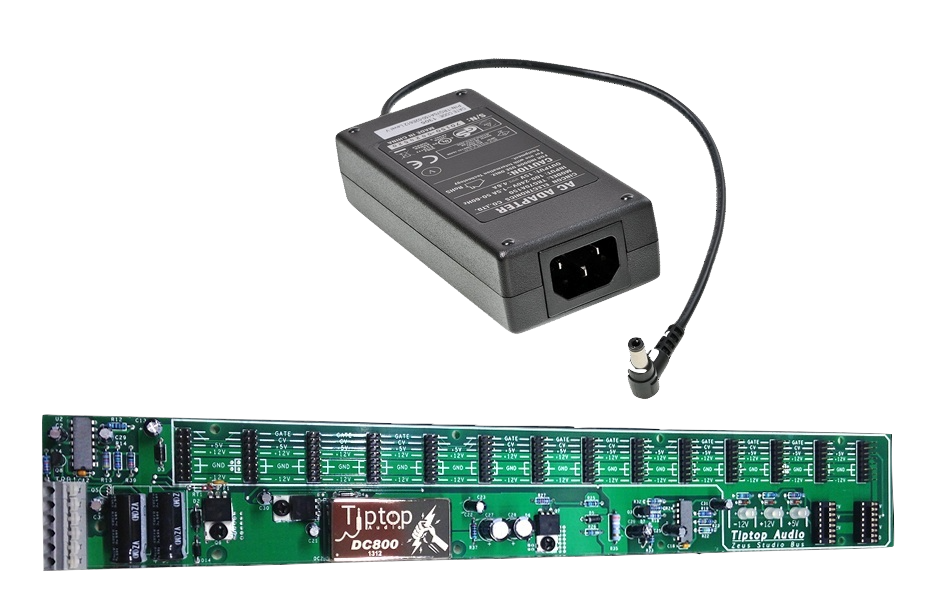 Power is no longer an issue, but 10 years ago there were only very few good Power Supplies. I still own my TipTop Zeus Studiobus with a 4.6A PSU, which I think is very good. I used to use three Studiobus boards, today just a single one.
Power is no longer an issue, but 10 years ago there were only very few good Power Supplies. I still own my TipTop Zeus Studiobus with a 4.6A PSU, which I think is very good. I used to use three Studiobus boards, today just a single one.
Although I don't mind the extra-large toroidal transformers in the MOTM, I found toroidal transformers in my first Eurorack case to be very disturbing - especially because you handle around in the instrument very often (e.g. when changing modules). They also make the instrument significantly heavier. The Studiobus was a real relief.
I am also very satisfied with the small "4MS Row Power" (my power supply for the Eurorack modules in the Buchla). In the meantime I also have a "CP1A" by Behringer, which works fine

